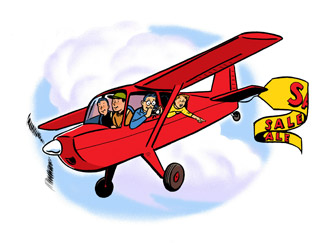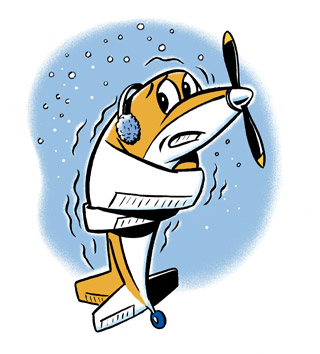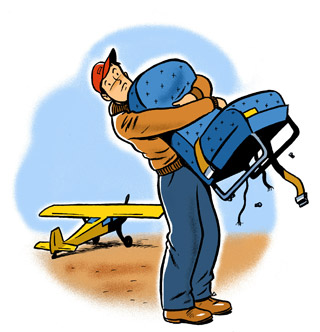Illustration By A.J. Garces
Here are some practical ways to lower flying costs gathered from the personal experiences of AOPA staff pilots, and fellow pilots through AOPA Forums and the AOPA Facebook page. Thanks to one and all for sharing these thrifty practices.
Do it yourself
 Do as much preventive maintenance as you’re allowed under FAR Part 43, starting with your own oil changes. The required tools for an oil change cost less than $150 (if you buy them all new); some FBOs charge twice that for a single service. You’ll be ahead after completing the first one—and you’ll know your airplane better, too, and perhaps be able to spot potential future problems before they become critical. (Also, buy oil by the case. It’s far less expensive than a quart at a time, even with shipping costs.)
Do as much preventive maintenance as you’re allowed under FAR Part 43, starting with your own oil changes. The required tools for an oil change cost less than $150 (if you buy them all new); some FBOs charge twice that for a single service. You’ll be ahead after completing the first one—and you’ll know your airplane better, too, and perhaps be able to spot potential future problems before they become critical. (Also, buy oil by the case. It’s far less expensive than a quart at a time, even with shipping costs.)
Rotate your main tires. Most aircraft tires wear faster on the outer portion near the sidewalls, and many aircraft owners discard their tires when the tread starts to wear thin. Turning the tires on the rims can double a tire’s useful life. (And when they’re worn out, consider retreads.)
Make your own engine preheater from an electrical space heater, or a Coleman-style camp stove, and eliminate the need for costly preheats. (Also, some camp stoves can burn the avgas drained from your fuel sump.) A homemade preheater can be made for about $50—that’s less than the cost of two preheats from most FBOs.
Assist with your own annual inspections. Most mechanics would prefer to skip the grunt work of removing and replacing inspection covers and lubricating wheel bearings. Participating in inspections lowers costs and improves your knowledge of your own aircraft.
Upgrade your skills
 Barter your nonflying skills. Trade your expertise in other areas for flying time, flight instruction, or aircraft maintenance. Get creative! Check with your accountant for any tax implications of bartering.
Barter your nonflying skills. Trade your expertise in other areas for flying time, flight instruction, or aircraft maintenance. Get creative! Check with your accountant for any tax implications of bartering.
Sit in a back seat, observe, and learn when others are getting dual instruction. Without the flying responsibilities, you can focus, listen to the instructor/student interaction, and learn even faster.
Get a commercial pilot certificate. Earn extra money towing gliders or banners; giving scenic rides; aerial photography; or ferrying airplanes—and build flight experience and qualifications along the way.
Use simulator training. You’ll learn more, and faster, while facing more challenging scenarios than you would ever attempt in an actual airplane.
Get a flight instructor certificate. You’ll learn a great deal about flying, gain experience, and have the satisfaction of helping others achieve their aviation dreams.
Shop around
Shop for aircraft insurance. Premiums have been dropping in recent years, and you may discover you can get a better rate from your current provider or a new one. Always be careful not to under-insure.
Rent airplanes in 10-hour blocks and many flight schools and FBOs will reduce the hourly rate.
Refinance your airplane while rates are down.
Negotiate a volume fuel discount from your FBO. The FBO owner will be glad to be paid up front, and you’ll get a reduced price per gallon.
New stuff
Get ADS-B weather and traffic. This can get complicated, depending on your ADS-B Out equipment. But assuming your airplane is ADS-B Out equipped—yes, it’s a big assumption—a Garmin GDL-39 will provide subscription-free weather and traffic for $800. (Note: In the 1990s, TCAS units that provided traffic only cost $100,000 or more each.)
Get ADS-B weather. If you already have an iPad, adding a Stratus system from Sporty’s Pilot Shop for $800 eliminates the need for a satellite weather subscription. (The least expensive satellite weather subscription is $35 a month, and if you include the price of XM receivers and activation charges, you’ll be ahead in about 18 months.)
Fly with small tires. Oversized tundra tires look great, and they are necessary equipment in Alaska and some other remote locations. But concrete runways chew up soft rubber—and big tires increase drag, raise fuel consumption, and reduce range on every flight.
 Get an aircraft cover. Protecting aircraft paint, windshields, interiors, and avionics from the elements just makes sense.
Get an aircraft cover. Protecting aircraft paint, windshields, interiors, and avionics from the elements just makes sense.
Get a tablet computer for use as an electronic flight bag. The savings from printed VFR and IFR charts alone can pay for an iPad in a single year (and AOPA members get steep discounts on FlyQ).
Upgrade your old, passive headset for $95. The in-ear system from CEP gives old headsets new life. Sure, you’ve got to wear ear buds, but the sound quality is as good as a $1,000 headset, and the noise protection may be even better. (See www.cep-usa.com.)
Replace a magneto with an FAA-certified ElectroAir electronic ignition. Your engine will run smoother; start easier; and on a typical four-cylinder Lycoming, it will reduce fuel consumption by one gallon an hour or more. For FAA-certified aircraft, an ElectroAir unit costs $3,400 and the break-even point on fuel savings alone comes at about 600 flight hours. For Experimental airplanes, an ElectroAir unit costs about $1,950, so the payoff comes sooner. And actual savings are greater because you cut the cost of 500-hour magneto overhauls in half.
Get matched fuel injection nozzles and run your engine lean of peak. A set of GAMI injectors for a six-cylinder Continental engine costs about $800. On a normally aspirated IO-550, fuel consumption typically drops from 18 gallons per hour rich of peak to 14 gph on the lean side. Saving 4 gph ($22) an hour, you’ll cover the cost of the injectors in less than 40 flight hours—and your engine will run cleaner, cooler, and last longer, too.
Technique
Fly higher. Strap on the oxygen and fly above 12,500 feet to stretch range, reduce fuel consumption, and avoid intermediate stops. Filling your own oxygen bottles helps, too.
Use a handheld radio to pick up your IFR clearance before engine start. If there’s a delay, at least you won’t have to wait with the engine(s) running.
Fill out NASA forms if you have any doubt about flying errors. They can be a get-out-of-jail card in some situations and help to improve the aviation system.
Throttle back. If you’re not in a desperate hurry, slow down. Reducing engine power from 75 percent to 65 percent typically cuts airspeed about 5 percent and fuel consumption 15 percent or more.
Join up
Join the Civil Air Patrol. Sharpen your flying skills, fly some great airplanes, have a positive influence on young cadets, work with some dedicated volunteers—and maybe even save a life.
Join a flying club for the lowest hourly rates (and the most flying enjoyment).
Volunteer for charitable flying through the Air Care Alliance. You’ll do good deeds through Pilots ’n Paws, Angel Flight, Bahamas Habitat, and many others—you’ll have a great time, too. Also, charitable flying is tax deductible.
Join a type club. Maintenance and operational tips alone can more than cover the annual dues.
Join AOPA Pilot Protection Services. Aviation attorneys such as John and Kathy Yodice don’t work cheap, but you can get them in your corner for as little as $39 a year.
Form a partnership and cut ownership costs by half, two thirds, or three quarters.
Make full use of your AOPA membership. Many members seldom, if ever, take advantage of free services such as the Pilot Information Center, whose staff can answer just about any aviation-related question; take free online courses from the AOPA Air Safety Institute; seek advice from our aviation medical experts; and get AOPA Lifestyle discounts.
Ownership strategies
Buy an Experimental airplane. Any A&P can perform the condition inspections, and some amateur-built designs have stellar performance.
Get an Experimental-category Light Sport aircraft, or E-LSA. Attend a two-day maintenance course and you can perform condition inspections and other maintenance on your own aircraft.
 Fly a single-seat airplane. A single-seat Pitts Special is about half the cost of a two-seat model (and no one really wants to come with you when you’re looping, rolling, and spinning anyway).
Fly a single-seat airplane. A single-seat Pitts Special is about half the cost of a two-seat model (and no one really wants to come with you when you’re looping, rolling, and spinning anyway).
Buy a new airplane. Tax incentives, such as 50-percent depreciation, have rarely been more advantageous to some businesses and individuals.
Get an auto fuel STC if one is available for your aircraft. Hundreds are available, and fuel prices can be half the cost of avgas.
Consider flying beyond TBO. If your engine has good compression, normal oil consumption, and oil analysis shows no signs of unusual wear, keep on flying. (Only commercial operators are required to replace engines at TBO.)
Buy a used airplane. Prices are at historic lows.
Express your individuality with stickers and vinyl airplane graphics. They’re a lot less expensive than a full paint job, and the next owner can peel them off if he or she has different tastes.
Visit www.aopa.org/pilot/waystosave to add your suggestions.


